If you’re wondering which guitar is for you, ESP Vs Ibanez, there’s no “one guitar brand fits all” answer. You need to examine all the pros and cons and then decide. Having prior experience with guitars can help you along your way to making the best decision.
Keep on reading to get all the information you need, even if this is your first guitar purchase! Click here if you’re in a hurry and want to skip directly to the comparison table.
You can use the table of contents below to take you to the area that interests you. Click on the little box to open it, and then click on the section of the article you want to read, or you can read from start to finish if you want the full guitar comparison experience!
The Short Answer
ESP predominantly makes guitars with “darker” sounds for Hard Rock and Metal, while Ibanez makes models with “brighter,” more balanced sounds for any musical genre. When comparing ESP to Ibanez guitars, it’s essential to look at the neck and body shape, tonewoods, pickup type, hardware, and overall cost. Try similar models to see which guitar has the sound and playability you’re looking for.
Keep On Reading (Below) To Learn More
Why Compare ESP To Ibanez Guitars?
I find that Rock and especially Metal players tend to gravitate toward ESP and Ibanez guitars. Kramer and Charvel are popular alternatives, which will be discussed in a forthcoming article.
Comparing ESP to Ibanez products can be challenging because there are often more similarities than differences. I’ve seen even seasoned players become very frustrated when they can’t decide on one particular guitar brand.
The more research you do and the more guitars you play, the easier your job will be.
ESP Vs Ibanez Comparison

Here are some of the ways these guitars may differ or be similar. They are helpful generalizations, but there are also many exceptions.
| Comparison | ESP/LTD Guitars | Ibanez Guitars |
|---|---|---|
| Neck | Flat and thin | Wide variety of shapes |
| Body | Alder, ash, mahogany, basswood, poplar | Alder, ash, mahogany, basswood, poplar |
| Pickups | Passive and active | Passive and active |
| Hardware | Wide range of quality and options | Wide range of quality and options |
| Tone | Darker | More versatile |
| Music Genre | Predominantly Rock & Metal | Pop, Rock, Metal, Jazz |
| Cost | Hundreds-thousands of dollars | Hundreds-thousands of dollars |
Keep On Reading (Below) To Learn More About Each Topic
ESP Vs. Ibanez Target Market
ESP has traditionally made guitars that appeal more to the Metal genre players, while Ibanez has catered to a wider market, such as Rock, Metal, and Jazz (hollow and semi-hollow body) players.
Overall, Ibanez has a range of guitar models that are more suitable for a wider variety of players.
How About ESP Vs LTD?
So, What’s The Difference Between ESP And LTD?
ESP and LTD are two different product lines that are made by ESP. The ESP line features higher-end guitars, while LTD is ESP’s more affordable beginner’s line. The ESP line is typically handcrafted in the US and Japan. The LTD line is assembled on a production line in Korea and Indonesia.
Construction
Here are some main points that apply to the construction of ESP/LTD and Ibanez guitars. Both these companies make guitars with various qualities, depending on price. Overall, the construction quality is good to great. Even the entry-level guitars for beginning players offer construction on par with the Fender Squier line.
Neck
The guitar necks are typically bolt-on for the cheaper models and neck-through-body for the more expensive ones, although some models feature a set (glued-in) neck. The neck-through-body design is more commonly found on the ESP guitars.
Ibanez electrics can feature the Wizard II neck, which is very thin and typically flatter (larger fingerboard radius) than the ESP/LTD models.
ESP and LTD neck design feature more of a flat shallow-U-shaped design. I love the feeling of the ESP necks on the Flying V body design!
The necks on all the ESP/LTD and Ibanez Metal models are designed to play superfast to accommodate shredding and two-handed tapping.
Neck-Through-Body Design
The neck-through-body design has a neck that runs through the entire length of the guitar. The body’s two halves (wings) are glued onto both sides of the neck. This gives better note sustain since the nut and bridge vibrate on the same wood piece. It also allows the upper body to be carved away where it meets the end of the fingerboard for better access to the highest frets.
Here is an Ibanez Prestige RGT320ZRBB guitar that shows the five-piece neck going through the body. The mahogany body wings are glued onto both sides of the maple neck.
On the back view, you can see how the neck and body carve allow for exceptional upper fret access without creating a problem with neck instability!


ESP also makes neck-through-body guitars, like the E-II M-II NECK THRU model.
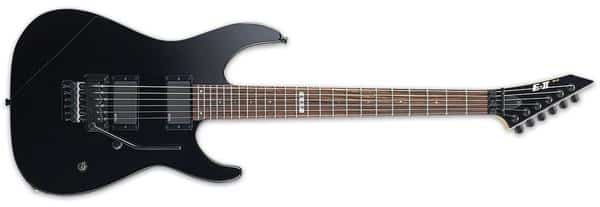
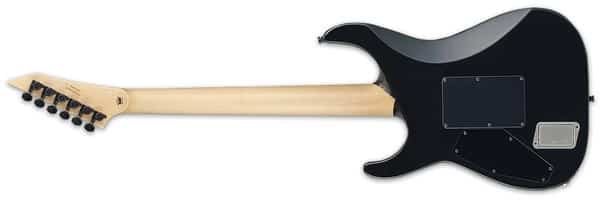
Body
While ESP and LTD guitars feature mostly Strat and Flying V design bodies, Ibanez electrics come in more varied body shapes. In addition to solid-body electrics, Ibanez also makes a range of sem-hollow body and hollow-body electrics for Jazz and Pop music.
Tone Wood
The type of wood used in a guitar’s construction can significantly affect its tone, no matter what musical genre you play.
Alder, ash, and mahogany are usually featured on the higher-end ESP/LTD and Ibanez guitars. At the same time, poplar and basswood are found on the more introductory models, although there are some exceptions.
Electronic Components
The electronic components of a guitar consist of its pickups, pots, and switches. These are connected by wiring to an output jack, which delivers the audio signal to an amplifier.
The wire quality used to connect these electronic components is of lesser importance but is still something to consider.
Pickups
The most important consideration here is the type and quality of pickups available on a guitar. They can play a significant role in determining the guitar’s tone and signal output strength.
The type of pickup that would sound best for Metal is totally different than what you would use to play Jazz.
ESP/LTD and Ibanez guitars all feature high-quality pickups, although higher-priced models can offer better pickups. Like everything else, you get what you pay for in pickup design.
These two guitar manufacturers commonly use EMG and Seymour Duncan pickups. Fishman Fluence pickups can be found on some of the more expensive models.
Single-Coil Vs. Humbucker Pickups
ESP/LTD and the Ibanez guitars designed to accommodate Metal players are more likely to use humbucking than single-coil pickups.
Ibanez guitars come in more pickup combinations. For example, their “Super Strats” have bridge and neck humbuckers and a single-coil pickup in the middle (H-S-H configuration).
See Humbucker Pickups VS Single Coil – Improve Your Guitar Tone! for more info.
Passive Vs. Active Pickups
Passive pickups are simply one or two coils of wire wound around a bobbin. Permanent magnets inside the bobbin create a small current in the coil when a string is plucked.
Active guitar pickups have a battery-powered preamp and graphic equalizer circuit that controls the pickup’s volume and tone. The circuit can be attached to the pickup or separated from it.
Guitars typically come with passive pickups, but ESP/LTD and Ibanez offer active pickup designs. ESP/LTD has more models with active pickups than Ibanez because they focus more on the Metal genre market.
Here is an EMG 81 Active Ceramic Bridge Humbucker. It features a solderless installation that makes swapping your guitar pickups easy and quick.
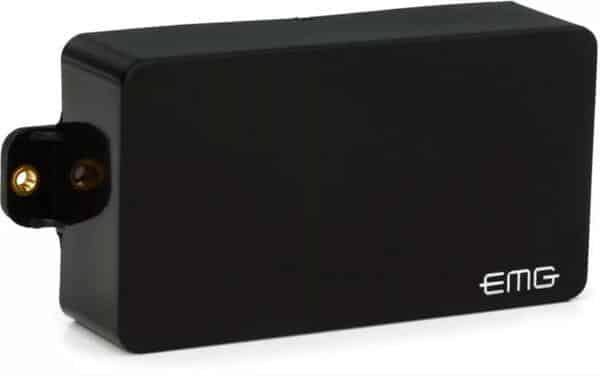
Pots And Switches
Pots (potentiometers) and pickup selector switches are the components that control the volume, tone, and pickup configuration of your guitar. Both ESP/LTD and Ibanez guitars feature high-quality and noise-free components.
Hardware
The most important hardware on an electric guitar is the tuning machines, bridge, and locking nut.
Tuning Machines
Tuning machines or machine heads wind the guitar’s string around a peg to tune the instrument. Some guitars have locking tuning machines, which lock the sting into the peg for better tuning stability and quicker string changes.
ESP/LTD and Ibanez guitars all have better-than-average tuning machines.
Bridge And Locking Nut
ESP/TLD and Ibanez guitars all feature fixed or tremolo bridges (with a whammy bar). The quality of the tremolo bridge can vary according to the model. Many higher-end guitars use Floyd Rose original or licensed tremolo bridges with a locking nut.
A locking nut keeps the strings from moving across the nut or slipping on the tuning machines. They work better than using locking tuners on guitars with tremolo bridges.
Ibanez guitars probably have more models with tremolo bridges than ESP/LTD.
Country Of Manufacture
The ESP line is typically handcrafted in the US and Japan. The LTD line is assembled on a production line in China, South Korea, and Indonesia.
Ibanez has a custom shop line that is made in the USA. Most assembly line models are made in Japan, China, and Indonesia.
How About Tone?
ESP and LTD guitars are typically designed to produce a darker and more aggressive sound, while Ibanez guitars are much more versatile.
I have an Ibanez RGT 42MDX that can cover rock and metal and an Ibanez JP20 Joe Pass hollow body made for playing Jazz.
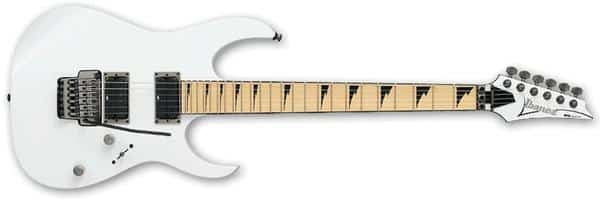

Ibanez guitars are available in a broader range of tonewoods than ESP guitars.
ESP and Ibanez guitars are available with passive and active pickups. The active pickups on ESP guitars have less tone versatility than the Ibanez models.
ESP Vs Ibanez Price Range
When you look at the price of ESP, LTD, and Ibanez guitars across the board, there is too broad a price range to make it a useful comparison.
Each guitar brand has models from the beginner to the pro range. LTD guitars are typically cheaper than ESP guitars, and Ibanez runs the gamut from affordable to very costly.
The best approach is to try several guitars in your price range for the genre of music you play and then decide. Expect to pay anywhere from $200 to $300 for an entry-level guitar, but the “pro” models are typically in the $2,000 to $2,500 range.
ESP, LTD, and Ibanez guitars are great for Hard Rock and Metal. If you also play some Mellow Rock, Pop, or Jazz, your best is to check out the Ibanez line.
Who Uses ESP/LTD Guitars?
The list of artists that use ESP and LTD guitars is extensive and includes mostly Metal players. Well-known guitarists include:
- Chuck Garric
- Frank Bello
- Adam “Nergal” Darski
- Tomasz Wróblewski
- Alexi Laiho
- Daniel Freyberg
- Michael Paget
- Craig Goldy
- Johnny Moeller
- Bruce Kulick
- Tommy Stinson
- Warren McRae
- Joe Stump
- Glenn Tipton
- Brian “Head” Welch
- George Lynch
- Mike Wead
- Andy LaRocque
- Willie Adler
- John Campbell
- Bill Kelliher
- JJ Sansaverino
- James Hetfield
- Kirk Hammett
- Adam Wakeman
- Michael Wilton
- Doug Scarratt
- Nibbs Carter
- Jeff Hanneman
- Tom Araya
- Gary Holt
- Ben Weinman
- Rick Marcel
- Ron Wood
- Barry Sparks
- Blackie Lawless
- Mike Duda
- Douglas Blair
- Piggy D
Who Uses Ibanez Guitars?
A wider variety of artists in all genres use Ibanez guitars. Here is a partial list:
- Lari Basilio
- Jake Bowen
- JB Brubaker
- Mario Camarena
- Paul Gilbert
- Mårten Hagström
- Erick Hansel
- Tim Henson
- Luke Hoskin
- Scott LePage
- Kiko Loureiro
- Martin Miller
- Munky
- Ichika Nito
- Noodles
- Tom Quayle
- Joe Satriani
- Josh Smith
- Paul Stanley
- Nita Strauss
- Fredrik Thordendal
- Andy Timmons
- Steve Vai
- Paul Waggoner
- Yvette Young
- Kou Zhengyu
- Bora Öksüz
- Kale Adam
- Damián Agurto
- Simon Andersson
- Cory Arford
- Sam Bell
- Geoff Brouillette
- Rob Purnell
- Barry Stock
- Mat Welsh
- Hikaru Yoshida
- Yusuke
- Jan Zehrfeld
Is One Brand Clearly Better Than The Other?
No, not really. ESP and Ibanez both make very high-quality guitars. Even the lower-priced LTD models are comparable to some Ibanez instruments.
It’s more important to pick the guitar that plays best in your hands and gives you the sound you want. All these guitars come in a variety of excellent-looking body shapes.
Ibanez guitars may have a slightly thinner neck, designed for shredders, while ESP/LTD guitars seem more popular among Metal players that prefer active pickups.
You can’t go wrong with ESP/LTD and Ibanez, regardless of which model you choose!
Beware Of Brand Knock-Offs

There are guitars on the market that look like ESP/LTD or Ibanez guitars and have very similar brand names, also known as “knock-offs.” The low price may be attractive to beginning players.
Many of them don’t stay in tune, won’t play well, and have low-quality components that create an undesirable sound.
Knock-off guitars have a very poor resale value!
You are probably better off waiting until you have the money to buy an entry-level LTD, Ibanez, or a Fender Squier Strat.
Frequently Asked Questions

Here are some of the questions I get asked about ESP, LTD, and Ibanez guitars.
If your question does not appear here, please put it in the comments, and I will get right back to you with an answer.
Is ESP Better Than Jackson?
The American hand-made ESP guitars are typically higher quality, but both companies make excellent shred guitars; it’s really a matter of personal preference. ESP necks are usually a little larger and more curved than the Jackson guitar necks.
In my opinion, if you want a more “Metal-ready” guitar, then check out the ESP. If you are a shred-head, Jackson guitars are ideal for ripping scales and two-handed tapping.
What Does LTD Mean On ESP Guitars?
It stands for “limited.” These guitars are more like SE (student edition) models than the higher-end ESP guitars but don’t be fooled. They are excellent sounding and playing shred machines!
What ESP Does Kirk Hammett Use?
Kirk Hammett has used several ESP signature series guitars. The ESP LTD Kirk Hammett Signature KH-602 has a Strat body with a double-locking tremolo.
However, for 2022 ESP has designed the Kirk Hammett LTD KH-V signature Flying-V body with a fixed bridge, which is an excellent version of his ESP Custom Shop guitar.
What Does Ibanez Stand For?
The Ibanez brand originally got its name from a line of acoustic guitars named after the Spanish luthier Salvador Ibanez. Eventually, the brand name was changed to Ibanez.
What Does RG In Ibanez Stand For?
The RG is popularly thought to stand for “rock guitar,” but it harkens back to the days of the “Roadster guitar” and Roadster II Series that were made in the ’80s.
Is Ibanez Expensive?
Ibanez has a wide range of guitars to fit almost every budget and playing style. They can start in the $200 to $300 range for the GIO model and go up to $8,000 or higher. Their typical high-end electrics are in the $2,000 to $2,500 range.
Final Thoughts

When comparing ESP Vs Ibanez guitars, there are various important factors to consider.
The neck shape and thickness can affect significantly affect an instrument’s playability. ESP necks tend to be slightly thicker and more curved than the Ibanez necks. Both neck types are great for playing Rock and Metal.
Neck and body tonewoods play a crucial role in how the guitar acoustically resonates. ESP and Ibanez both use a full range of tonewoods consisting primarily of alder, ash, mahogany, basswood, and poplar.
Pickups are always a major consideration. ESP and Ibanez consistently use pickups that are very responsive to playing style and have great sound. ESP tends to have more of an emphasis on using active pickups in their product line than Ibanez. Overall, ESP guitars may have a “Darker Metal” tone than Ibanez instruments.
The quality of hardware used on ESP and Ibanez guitars can vary, depending on the model and cost. Ibanez tends to use more tremolo bridges than ESP.
While ESP guitars primarily attract Rock and Metal players, Ibanez makes guitars for all musical genres, including semi-hollow and hollow-body electric guitars for Pop and Jazz.
ESP makes a more affordable guitar line called LTD, which stands for Limited.” LTD guitars are an excellent buy for the money.

Check Out This Action!
Since you’ve come this far, here’s a special treat! If you like Rock and Metal, check out this video from MetaDemiurge. It features many of my favorite players, like Steve Vai, Joe Satriani, and James Hetfield, playing various ESP, LTD, and Ibanez guitars!
Tell Me What You Think

Please leave a comment below if you enjoyed this article, have any questions about ESP Vs Ibanez guitars, or want to give your point of view. I will be happy to help you.
- Do you own an ESP, LTD, or Ibanez guitar? Tell us about it!
- Which guitar brand do you prefer, ESP, LTD, or Ibanez? Why?
- Did this article help you to understand the differences between ESP, LTD, and Ibanez?
- Any questions related to these guitar brands?
- What else is on your mind?

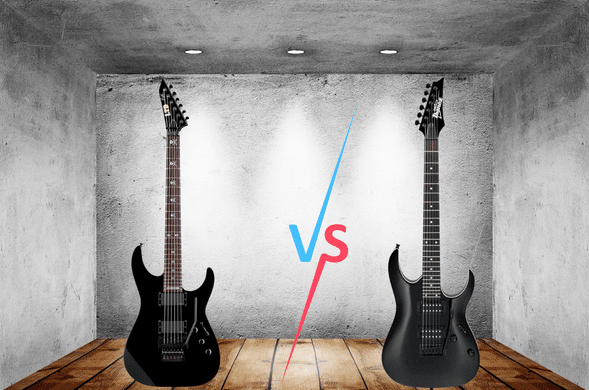

Very intriguing article! I am beginning to get into guitar so this is very helpful! When I first discovered this article I didn’t heavily know the difference between these two types of guitars. But now I feel like I can’t definitely choose which one would suit me more! I think I would side more with the ESP guitar. Great content!
Hi, Alex
Thank You for you comments!
If your looking for a beginner’s Metal guitar I recommend the ESP LTD models, which are considerably cheaper and sound great. The Ibanez guitars have a brighter and more balanced tone.
Let me know if you have any questions and I’ll be glad to help!
Keep On Rockin’ 🤘
Frank 🎸
Hi Frank,
Thanks for sharing your vast knowledge of all types and styles of guitar. You clearly know all about your guitar niche. Your website is indicative of your passion and expertise.
However, the terminology is quite advanced for my vocabulary. Your layout is quite outstanding. With the body of knowledge that you have, I clearly understand that this is just another day at the office for you. To make an educated guess, I’d say you are about 150 IQ.
Your guitar repertoire is quite unique. I learned quite a bit at The University of Guitars 101.For guitar enthusiasts, far and wide, your website is a well-stocked epicenter of everything guitar. Do you live and breathe guitar language? Thanks for sharing your world. You have curated a masterpiece, my friend. I got a lot of cramming to do to take it all in.
How much time did you spend developing your guitar studio? About how many guitars do you own and would you ever auction them off. You will probably get a lot. This was fun rocking with you and keep on rocking.
Rachele
Hi, Rachele
Thank You so much for your comments and compliments. You are too kind!
Yes, I do live and breathe guitar language! 😎
I have been playing, teaching, buying, and building guitars for approximately 50 years and have about 70 instruments.
I’m thrilled that you enjoyed the article! If you’re not a fairly seasoned guitar player, the terminology in a review article like this can be a little challenging to follow.
Please come back to revisit my website!
Keep On Rockin’ 🤘
Frank 🎸
have you tried ESP’s Extra Thin-U neck?
How does it feel? Is it really thin and good for players with smaller hands? thanks!
Hi, Steven
Thank You for your question!
The ESP Extra Thin U Neck seems a little thinner (very little) in my hand than an Ibanez Wizard neck, and it feels great to play. They are both good necks for players with small hands, but it really depends on what kind of neck you like the feel of and not so much your hand size.
If you have a Guitar Center nearby, go play one and see what you think. If they don’t have one in stock, see if you can convince them to get one from another store.
Rock On,?
Frank ?